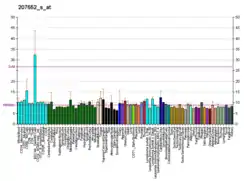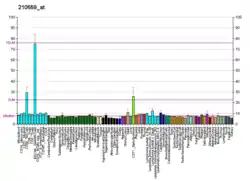CMKLR1
Chemokine like receptor 1 also known as ChemR23 (Chemerin Receptor 23) is a protein that in humans is encoded by the CMKLR1 gene.[5][6] Chemokine receptor-like 1 is a G protein-coupled receptor for the chemoattractant adipokine chemerin[7] and the omega-3 fatty acid eicosapentaenoic acid-derived specialized pro-resolving molecule, resolvin E1 (see Specialized proresolving mediators#EPA-derived resolvins (i.e. RvE)).[8] The murine receptor that shares almost 80% homology with the human receptor, is called Dez.[9]
Tissue distribution
CMKLR1 shows wide RNA expression profile but is notably high in plasmacytoid dendritic cells, macrophages, cardiomyocytes, adipocytes and endothelial cells.[10]
Function
Activating CMKLR1 by an agonist mobilizes intracellular calcium and causes the activation of several other signaling cascades like the ERK1 and NF-κB. Initial studies of CMKLR1 suggested that it might have a role in the inflammatory pathways. Its cognate ligand, chemerin was found in joint aspirate from rheumatoid arthritis and absent in aspirate from degenerative arthritis. CMKLR1 expression by plasmacytoid dendritic cells and macrophages also helped foster this idea. In vitro chemotaxis assays showed it to be utilized in attracting these cells. As an adipokine receptor it has a role in adipogenesis and adipocyte maturation.[11] It seems also to have a role in peripheral insulin resistance.[12]
Also studies using the mouse zymosan model and chemerin peptides showed that these peptides suppressed and helped resolve the peritonitis in mice.[13] The same model showed that this particular molecule enhances macrophage efferocytosis (phagocyting apoptotic cells).[14]
Receptor antagonist CCX832
CCX832 is an orally active molecule used as a tool compound in experimental pharmacology. It antagonises the effect of CMKLR1.[15][16][17] It is listed on the Guide to Pharmacology database as the only example of a CMKLR1 antagonist. Its chemical structure is undisclosed.[18]
The substance was originally developed for use as a pharmaceutical drug against inflammatory diseases by ChemoCentryx, a pharmaceutical firm based in California, in alliance with GlaxoSmithKline (GSK).[19] Development was terminated after a Phase I clinical trial in 2012.[20]
References
- GRCh38: Ensembl release 89: ENSG00000174600 - Ensembl, May 2017
- GRCm38: Ensembl release 89: ENSMUSG00000042190 - Ensembl, May 2017
- "Human PubMed Reference:". National Center for Biotechnology Information, U.S. National Library of Medicine.
- "Mouse PubMed Reference:". National Center for Biotechnology Information, U.S. National Library of Medicine.
- "Entrez Gene: CMKLR1 chemokine-like receptor 1".
- Gantz I, Konda Y, Yang YK, Miller DE, Dierick HA, Yamada T (1996). "Molecular cloning of a novel receptor (CMKLR1) with homology to the chemotactic factor receptors". Cytogenetics and Cell Genetics. 74 (4): 286–90. doi:10.1159/000134436. PMID 8976386.
- Wittamer V, Franssen JD, Vulcano M, Mirjolet JF, Le Poul E, Migeotte I, Brézillon S, Tyldesley R, Blanpain C, Detheux M, Mantovani A, Sozzani S, Vassart G, Parmentier M, Communi D (October 2003). "Specific recruitment of antigen-presenting cells by chemerin, a novel processed ligand from human inflammatory fluids". The Journal of Experimental Medicine. 198 (7): 977–85. doi:10.1084/jem.20030382. PMC 2194212. PMID 14530373.
- Arita M, Bianchini F, Aliberti J, Sher A, Chiang N, Hong S, Yang R, Petasis NA, Serhan CN (March 2005). "Stereochemical assignment, antiinflammatory properties, and receptor for the omega-3 lipid mediator resolvin E1". The Journal of Experimental Medicine. 201 (5): 713–22. doi:10.1084/jem.20042031. PMC 2212834. PMID 15753205.
- Methner A, Hermey G, Schinke B, Hermans-Borgmeyer I (April 1997). "A novel G protein-coupled receptor with homology to neuropeptide and chemoattractant receptors expressed during bone development". Biochemical and Biophysical Research Communications. 233 (2): 336–42. doi:10.1006/bbrc.1997.6455. PMID 9144535.
- Kaur J, Adya R, Tan BK, Chen J, Randeva HS (January 2010). "Identification of chemerin receptor (ChemR23) in human endothelial cells: chemerin-induced endothelial angiogenesis" (PDF). Biochemical and Biophysical Research Communications. 391 (4): 1762–8. doi:10.1016/j.bbrc.2009.12.150. PMID 20044979.
- Goralski KB, McCarthy TC, Hanniman EA, Zabel BA, Butcher EC, Parlee SD, Muruganandan S, Sinal CJ (September 2007). "Chemerin, a novel adipokine that regulates adipogenesis and adipocyte metabolism". The Journal of Biological Chemistry. 282 (38): 28175–88. doi:10.1074/jbc.M700793200. PMID 17635925.
- Takahashi M, Takahashi Y, Takahashi K, Zolotaryov FN, Hong KS, Kitazawa R, Iida K, Okimura Y, Kaji H, Kitazawa S, Kasuga M, Chihara K (March 2008). "Chemerin enhances insulin signaling and potentiates insulin-stimulated glucose uptake in 3T3-L1 adipocytes". FEBS Letters. 582 (5): 573–8. doi:10.1016/j.febslet.2008.01.023. PMID 18242188. S2CID 41312338.
- Cash JL, Hart R, Russ A, Dixon JP, Colledge WH, Doran J, Hendrick AG, Carlton MB, Greaves DR (April 2008). "Synthetic chemerin-derived peptides suppress inflammation through ChemR23". The Journal of Experimental Medicine. 205 (4): 767–75. doi:10.1084/jem.20071601. PMC 2292217. PMID 18391062.
- Cash JL, Christian AR, Greaves DR (May 2010). "Chemerin peptides promote phagocytosis in a ChemR23- and Syk-dependent manner". Journal of Immunology. 184 (9): 5315–24. doi:10.4049/jimmunol.0903378. PMC 4237835. PMID 20363975.
- Ramos-Junior ES, Leite GA, Carmo-Silva CC, Taira TM, Neves KB, Colón DF, da Silva LA, Salvador SL, Tostes RC, Cunha FQ, Fukada SY (December 2016). "Adipokine Chemerin Bridges Metabolic Dyslipidemia and Alveolar Bone Loss in Mice". Journal of Bone and Mineral Research. 32 (5): 974–984. doi:10.1002/jbmr.3072. PMID 28029186.
- Kennedy AJ, Yang P, Read C, Kuc RE, Yang L, Taylor EJ, Taylor CW, Maguire JJ, Davenport AP (October 2016). "Chemerin Elicits Potent Constrictor Actions via Chemokine-Like Receptor 1 (CMKLR1), not G-Protein-Coupled Receptor 1 (GPR1), in Human and Rat Vasculature". Journal of the American Heart Association. 5 (10): e004421. doi:10.1161/JAHA.116.004421. PMC 5121526. PMID 27742615.
- Darios ES, Winner BM, Charvat T, Krasinksi A, Punna S, Watts SW (August 2016). "The adipokine chemerin amplifies electrical field-stimulated contraction in the isolated rat superior mesenteric artery". American Journal of Physiology. Heart and Circulatory Physiology. 311 (2): H498-507. doi:10.1152/ajpheart.00998.2015. PMC 5008655. PMID 27371688.
- "Chemerin receptor – IUPHAR/BPS Guide to Pharmacology". www.guidetopharmacology.org. Retrieved 7 April 2017.
- "ChemoCentryx Identifies Novel Small Molecule ChemR23 Antagonist for the Treatment of Inflammatory Diseases". ChemoCentryx. 2010-04-10. Archived from the original on 2011-05-19. Retrieved 2017-04-14.
- "ChemoCentryx, GSK discontinue ChemR23 antagonist". BioCentury. 7 February 2012.
External links
Further reading
- Owman C, Lolait SJ, Santén S, Olde B (December 1997). "Molecular cloning and tissue distribution of cDNA encoding a novel chemoattractant-like receptor". Biochemical and Biophysical Research Communications. 241 (2): 390–4. doi:10.1006/bbrc.1997.7822. PMID 9425281.
- Samson M, Edinger AL, Stordeur P, Rucker J, Verhasselt V, Sharron M, Govaerts C, Mollereau C, Vassart G, Doms RW, Parmentier M (May 1998). "ChemR23, a putative chemoattractant receptor, is expressed in monocyte-derived dendritic cells and macrophages and is a coreceptor for SIV and some primary HIV-1 strains". European Journal of Immunology. 28 (5): 1689–700. doi:10.1002/(SICI)1521-4141(199805)28:05<1689::AID-IMMU1689>3.0.CO;2-I. PMID 9603476.
- Hillman RT, Green RE, Brenner SE (2005). "An unappreciated role for RNA surveillance". Genome Biology. 5 (2): R8. doi:10.1186/gb-2004-5-2-r8. PMC 395752. PMID 14759258.
- Mårtensson UE, Fenyö EM, Olde B, Owman C (November 2006). "Characterization of the human chemerin receptor--ChemR23/CMKLR1--as co-receptor for human and simian immunodeficiency virus infection, and identification of virus-binding receptor domains". Virology. 355 (1): 6–17. doi:10.1016/j.virol.2006.07.010. PMID 16904155.
This article incorporates text from the United States National Library of Medicine, which is in the public domain.





